Inception of Constructional Submarine Conduit by Asymmetry Generated by Turbidity Current
Abstract
1. Introduction
1.1. Submarine Conduits
1.2. Phenomenon Magnitude: Process Scale
1.3. Conduit Inception
2. Materials and Methods
2.1. Experimental Apparatus
2.2. Experiments
3. Results
3.1. Series I
3.2. Series II
4. Discussion
4.1. Construction Mechanism of the Conduit Observed
4.2. Scale Effect (Similarity Analysis)
- Velocity (V): It is estimated that the velocity in the model ranged between 0.05 and 0.10 m/s, with an average value of 0.08 m/s. In the prototype (natural environment), these velocities reach average values of 2.50 m/s [99];
- Density of the mixture (ρ): Considering a mixture with a sediment concentration of 10% by volume, the density of the mixtures in the model ranges around 1028–1057 kg/m3. In the prototype, considering quartz, the density is around 1175 kg/m3;
- Current thickness (H): In nature, the most common flows have a current height of about 2.50 m, whereas in the model, a representative value of 0.05 m can be considered.
4.3. Conduit Inception Model
5. Conclusions
Author Contributions
Funding
Institutional Review Board Statement
Informed Consent Statement
Data Availability Statement
Acknowledgments
Conflicts of Interest
References
- Dana, J.D. A Manual of Geology, 4th ed.; Theodore Bliss & Co.: Philadelphia, PA, USA, 1863; p. 798. [Google Scholar]
- Kuenen, P.H.; Migliorini, C.I. Turbidity currents as a case of graded bedding. J. Geol. 1950, 58, 91–127. [Google Scholar] [CrossRef]
- Menard, H.W. Deep-sea channels, topography, and sedimentation. AAPG Bull. 1955, 39, 236–255. [Google Scholar]
- Shepard, F.P.; Dill, R.F. Submarine Canyons and Other Sea Valleys, 1st ed.; Rand McNally & Co.: Chicago, IL, USA, 1966; p. 381. [Google Scholar]
- Shepard, F.P. Submarine Geology, 3rd ed.; Harper & Row Publishers: New York, NY, USA, 1973; p. 517. [Google Scholar]
- Bagnold, R.A. Mechanics of marine sedimentation. In The Sea; Hill, M.N., Ed.; Wiley: New York, NY, USA, 1976; pp. 507–528. [Google Scholar]
- Shepard, F.P. Transportation of sand into deep water. SEPM Spec. Publ. 1951, 2, 53–65. [Google Scholar]
- Ericson, D.B.; Ewing, M.; Heezen, B.C. Turbidity Currents and Sediments in the North Atlantic. AAPG Bull. 1952, 36, 489–511. [Google Scholar]
- Kuenen, P.H. Properties of turbidity currents of high density. SEPM Spec. Publ. 1951, 2, 14–33. [Google Scholar]
- Heezen, B.C.; Ewing, M. Turbidity currents and submarine slumps, and the 1929 Grand Banks earthquake. Am. J. Sci. 1952, 250, 849–873. [Google Scholar] [CrossRef]
- Lowe, D.R. Sediment gravity flows. 2. Depositional models with special reference to high density turbidity currents. J. Sed. Petrol. 1982, 52, 279–298. [Google Scholar]
- Mulder, T.; Syvitski, J.P.M. Turbidity Currents Generated at River Mouths during Exceptional Discharges to the World Oceans. J. Geol. 1995, 103, 285–299. [Google Scholar] [CrossRef]
- Mulder, T.; Alexander, A. The physical character of subaqueous sedimentary density flows and their deposits. Sedimentology 2001, 48, 269–299. [Google Scholar] [CrossRef]
- Piper, D.J.W.; Normark, W.R. Processes That Initiate Turbidity Currents and Their Influence on Turbidites: A Marine Geology Perspective. J. Sediment. Res. 2009, 79, 347–362. [Google Scholar] [CrossRef]
- Meiburg, E.; Kneller, B. Turbidity Currents and Their Deposits. Annu. Rev. Fluid Mech. 2010, 42, 135–156. [Google Scholar] [CrossRef]
- Stevenson, C.J.; Talling, P.J.; Wynn, R.B.; Masson, D.G.; Hunt, J.E.; Frenz, M.; Akhmetzhanhov, A.; Cronin, B.T. The flows that left no trace: Very large-volume turbidity currents that bypassed sediment through submarine channels without eroding the sea floor. Mar. Pet. Geol. 2013, 41, 186–205. [Google Scholar] [CrossRef]
- Bagnold, R.A. The flow of cohesionless grains in fluids. Philos. Trans. R. Soc. Lond. Ser. A Math. Phys. Sci. 1956, 249, 235–297. [Google Scholar] [CrossRef]
- Simpson, J.E. Gravity currents in the laboratory, atmosphere, and ocean. Ann. Rev. Fluid Mech. 1982, 14, 213–234. [Google Scholar] [CrossRef]
- Middleton, G.V.; Hampton, M.A. Sediment gravity flows: Mechanics of flow and deposition. In Turbidites and Deep-Water Sedimentation; Middleton, G.V., Bouma, A.H., Eds.; SEPM Pacific Section Short Course: Anaheim, CA, USA, 1973; pp. 1–38. [Google Scholar]
- Mutti, E.; Normark, W.R. Comparing examples of modern and ancient turbidite systems: Problems and concepts. In Marine Clastic Sedimentology: Concepts and Case Studies; Leggett, J.R., Zuffa, G.G., Eds.; Graham and Trotman: London, UK, 1987; pp. 1–37. [Google Scholar]
- Kneller, B.; Buckee, C. The structure and fluid mechanics of turbidity currents: A review of some recent studies and their geological implications. Sedimentology 2000, 47, 62–94. [Google Scholar] [CrossRef]
- Heerema, C.J.; Talling, P.J.; Cartigny, M.J.; Paull, C.K.; Bailey, L.; Simmons, S.M.; Parsons, D.R.; Clare, M.A.; Gwiazda, R.; Lundsten, E.; et al. What determines the downstream evolution of turbidity currents? Earth Planet. Sci. Lett. 2020, 532, 116023. [Google Scholar] [CrossRef]
- Bailey, L.P.; Clare, M.A.; Rosenberger, K.J.; Cartigny, M.J.B.; Talling, P.J.; Paull, C.K.; Gwiazda, R.; Parsons, D.R.; Simmons, S.M.; Xu, J.; et al. Preconditioning by sediment accumulation can produce powerful turbidity currents without major external triggers. Earth Planet. Sci. Lett. 2021, 562, 116845. [Google Scholar] [CrossRef]
- Wells, M.G.; Dorrel, R.M. Turbulence processes within turbidity currents. Annu. Rev. Fluid Mech. 2021, 53, 59–83. [Google Scholar] [CrossRef]
- Henry, P.; Özeren, M.S.; Yakupoglu, N.; Çakir, Z.; De Saint-Léger, E.; Desprez De Gésincourt, O.; Tengberg, A.; Chevalier, C.; Papoutsellis, C.; Postacloglu, N.; et al. Mass flows, turbidity currents and other hydrodynamic consequences of small and moderate earthquakes in the Sea of Marmara. Nat. Hazards Earth Syst. Sci. 2022, 22, 3939–3956. [Google Scholar] [CrossRef]
- Pope, E.L.; B Cartigny, M.J.; Clare, M.A.; Talling, P.J.; Gwyn Lintern, D.; Vellinga, A.; Hage, S.; Açikalin, S.; Bailey, L.; Chapplow, N.; et al. First source-to-sink monitoring shows dense head controls sediment flux and runout in turbidity currents. Sci. Adv. 2022, 8, eabj3220. [Google Scholar] [CrossRef] [PubMed]
- Viana, A.R.; Almeida, W., Jr.; Almeida, C.W. Upper slope sands: Late Quaternary shallow-water sandy contourites of Campos Basin, SW Atlantic Margin. In Deep-Water Contourite Systems: Modern Drifts and Ancient Series, Seismic and Sedimentary Characteristics; Stow, D.A.V., Pudsey, C.J., Howe, J.A., Faugères, J.-C., Viana, A.R., Eds.; Geological Society, London, Memoirs: London, UK, 2002; Volume 22, pp. 261–270. [Google Scholar]
- Mcgregor, B.A. The Submerged Continental Margin: Increasingly sophisticated technology has produced detailed images of the continental margin, giving a fuller picture of geologic processes under the sea. Am. Sci. 1984, 72, 275–281. [Google Scholar]
- Daly, R.A. Origin of submarine canyons. Am. J. Sci. 1936, 31, 410–420. [Google Scholar] [CrossRef]
- Shepard, F.P. Submarine Canyons: Multiple Causes and Long-Time Persistence. AAPG Bull. 1981, 65, 1062–1077. [Google Scholar]
- Fisher, W.L.; Galloway, W.E.; Steel, R.J.; Olariu, C.; Kerans, C.; Mohrig, D. Deep-water depositional systems supplied by shelf-incising submarine canyons: Recognition and significance in the geologic record. Earth Sci. Rev. 2021, 214, 103531. [Google Scholar] [CrossRef]
- Cerrillo-Escoriza, J.; Lobo, F.J.; Puga-Bernabéu, A.; Bárcenas, P.; Mendes, I.; Pérez-Asensio, J.N.; Durán, R.; Andersen, T.J.; Carrión Torrente, A.; García, M.; et al. Variable downcanyon morphology controlling the recent activity of shelf-incised submarine canyons (Alboran Sea, western Mediterranean). Geomorphology 2024, 453, 109127. [Google Scholar] [CrossRef]
- Stow, D.A.V.; Mayall, M. Deep-water sedimentary systems: New models for the 21st century. Mar. Pet. Geol. 2000, 17, 125–135. [Google Scholar] [CrossRef]
- Spencer, J.W. Submarine valleys off the American coasts and in the North Atlantic. Geol. Soc. Am. Bull. 1903, 14, 207–226. [Google Scholar] [CrossRef]
- Wegener, A. The Origin of Continents and Oceans; Dutton: New York, NY, USA, 1924; 212p. [Google Scholar]
- Bourcart, J. Essai sur les regressions et transgressions marines. Soc. Geol. Fr. Bull. 1938, 5, 393–474. [Google Scholar]
- Johnson, D.W. The Origin of Submarine Canyons, a Critical Review of Hypotheses; Columbia University Press: New York, NY, USA, 1939; 126p. [Google Scholar]
- Bucher, W.H. Submarine valleys and related geologic problems of the North Atlantic. Geol. Soc. Am. Bull. 1940, 51, 489–512. [Google Scholar] [CrossRef]
- Wynn, R.B.; Cronin, B.T.; Peakall, J. Sinuous deep-water channels: Genesis, geometry and architecture. Mar. Pet. Geol. 2007, 24, 341–387. [Google Scholar] [CrossRef]
- Vachtman, D.; Mitchell, N.C.; Gawthorpe, R. Morphologic signatures in submarine canyons and gullies, central USA Atlantic continental margins. Mar. Pet. Geol. 2013, 41, 250–263. [Google Scholar] [CrossRef]
- Pratson, L.F.; Ryan, W.B.F. Automated drainage extraction for mapping the Monterey submarine drainage system, California margin. Mar. Geophys. Res. 1996, 18, 757–777. [Google Scholar] [CrossRef]
- Field, M.E.; Clarke, S.H. Small-scale slumps and slides and their significance for basin slope processes, southern California borderland. In Geology of Continental Slopes: SEPM Special Publication; Doyle, L.J., Pilkey, O.H., Eds.; SEPM: Tulsa, Oklahoma, USA, 1979; Volume 27, pp. 327–342. [Google Scholar]
- Chiocci, F.L.; Casalbore, D. Submarine gullies on Italian upper slopes and their relationship with volcanic activity revisited 20 years after Bill Normark’s pioneering work. Geosphere 2011, 7, 1284–1293. [Google Scholar] [CrossRef]
- Duncan, C.S.; Goff, J.A.; Austin, J.A.; Fulthorpe, C.S. Tracking the last sea-level cycle: Seafoor morphology and shallow stratigraphy of the latest Quaternary New Jersey middle continental shelf. Mar. Geol. 2000, 170, 395–421. [Google Scholar] [CrossRef]
- Boss, S.K.; Hoffman, C.W.; Cooper, B. Influence of fluvial processes on the Quaternary geologic framework of the continental shelf, North Carolina, USA. Mar. Geol. 2002, 183, 45–65. [Google Scholar] [CrossRef]
- Maia, R.M.C.; dos Reis, A.T.; Alves, E.C.; Silva, C.G.; Guerra, J.V.; Gorini, C.; Silva, A.; Arantes-Oliveria, R. Architecture and Stratigraphic framework of shelf sedimentary systems off Rio de Janeiro State, Northern Santos Basin-Brazil. Braz. J. Oceanogr. 2010, 58, 15–29. [Google Scholar] [CrossRef]
- Kuehl, S.A.; Levy, B.M.; Moore, W.S.; Allison, M.A. Subaqueous delta of the Ganges-Brahmaputra river system. Mar. Geol. 1997, 144, 81–96. [Google Scholar] [CrossRef]
- Harris, P.T.; Hughes, M.G.; Baker, E.K.; Dalrymple, R.W.; Keene, J.B. Sediment transport in distributary channels and its export to the pro-deltaic environment in a tidally dominated delta: Fly River, Papua New Guinea. Cont. Shelf Res. 2004, 24, 2431–2454. [Google Scholar] [CrossRef]
- Twichell, D.C.; Roberts, D.G. Morphology, distribution, and development of submarine canyons in the United States Atlantic continental slope between Hudson and Baltimore Canyons. Geology 1982, 10, 408–412. [Google Scholar] [CrossRef]
- Straub, K.M.; Mohrig, D. Constructional canyons built by sheet-like turbidity currents: Observations from offshore Brunei Darussalam. J. Sediment. Res. 2009, 79, 24–39. [Google Scholar] [CrossRef]
- Lastras, G.; Acosta, J.; Muñoz, A.; Canals, M. Submarine canyon formation and evolution in the Argentine Continental Margin between 44°30′ S and 48° S. Geomorphology 2011, 128, 116–136. [Google Scholar] [CrossRef]
- Puga-Bernabéu, A.; Webster, J.M.; Beaman, R.J.; Guilbaud, V. Variation in canyon morphology on the Great Barrier Reef margin, north-eastern Australia: The influence of slope and barrier reefs. Geomorphology 2013, 191, 35–50. [Google Scholar] [CrossRef]
- Hodgson, D.M.; Peakall, J.; Maier, K.L. Submarine Channel Mouth Settings: Processes, Geomorphology, and Deposits. Front. Earth Sci. 2022, 10, 790320. [Google Scholar] [CrossRef]
- Kowsmann, R.O.; Viana, A.R. Movimentos de massa provocados por cunhas progradantes de nível de mar baixo: Exemplo na Bacia de Campos. BGP 1992, 6, 97–102. [Google Scholar]
- Mulder, T. Gravity Processes and Deposits on Continental Slope, Rise and Abyssal Plains. Dev Sedimentol. 2011, 63, 25–148. [Google Scholar] [CrossRef]
- Baeten, N.J.; Laberg, J.S.; Vanneste, M.; Forsberg, C.F.; Kvalstad, T.J.; Forwick, M.; Vorren, T.O.; Haflidason, H. Origin of shallow submarine mass movements and their glide planes—Sedimentological and geotechnical analyses from the continental slope off northern Norway. J. Geophys. Res. Earth Surf. 2014, 119, 2335–2360. [Google Scholar] [CrossRef]
- Kneller, B.; Dykstra, M.; Fairweather, L.; Milana, J.P. Mass-transport and slope accommodation: Implications for turbidite sandstone reservoirs. Am. Assoc. Pet. Geol. Bull. 2016, 100, 213–235. [Google Scholar] [CrossRef]
- Shanmugam, G. Deep-Water Processes and Facies Models: Implications for Sandstone Petroleum Reservoirs; Elsevier: Amsterdam, The Netherlands, 2006; p. 199. [Google Scholar]
- Gales, J.A.; Forwick, M.; Laberg, J.S.; Vorren, T.O.; Larter, R.D.; Graham, A.G.C.; Baeten, N.J.; Amundsen, H.B. Arctic and Antarctic submarine gullies—A comparison of high latitude continental margins. Geomorphology 2013, 201, 449–461. [Google Scholar] [CrossRef]
- Babonneau, N.; Savoye, B.; Cremer, M.; Klein, B. Morphology and architecture of the present canyon and channel system of the Zaire deep-sea fan. Mar. Pet. Geol. 2002, 19, 445–467. [Google Scholar] [CrossRef]
- Mayall, M.; Jones, E.; Casey, M. Turbidite channel reservoirs and key elements in facies prediction and effective development. Mar. Pet. Geol. 2006, 23, 821–841. [Google Scholar] [CrossRef]
- Heiniö, P.; Davies, R.J. Knickpoint migration in submarine channels in response to fold growth, western Niger Delta. Mar. Pet. Geol. 2007, 24, 434–449. [Google Scholar] [CrossRef]
- Piper, D.J.W.; Normark, W.R. Turbidite deposition patterns and flow characteristics, Navy Submarine Fan, Californian Borderland. Sedimentology 1983, 30, 681–694. [Google Scholar] [CrossRef]
- Baztan, J.; Berné, S.; Olivet, J.L.; Rabineau, M.; Aslanian, D.; Gaudin, M.; Réhault, J.P.; Canals, M. Axial incision: The key to understand submarine canyon evolution (in the western Gulf of Lion). Mar. Pet. Geol. 2005, 22, 805–826. [Google Scholar] [CrossRef]
- Kane, I.A.; Kneller, B.C.; Dykstra, M.; Kassem, A.; McCaffrey, W.D. Anatomy of a submarine channel-levee: An example from Upper Cretaceous slope sediments, Rosario Formation, Baja California, Mexico. Mar. Pet. Geol. 2007, 24, 540–563. [Google Scholar] [CrossRef]
- Surpless, K.D.; Ward, R.B.; Graham, S.A. Evolution and stratigraphic architecture of marine slope gully complexes: Monterey Formation (Miocene), Gaviota Beach, California. Mar. Pet. Geol. 2009, 26, 269–288. [Google Scholar] [CrossRef]
- Celis, S.A.; García-García, F.; Rodríguez-Tovar, F.J.; Giraldo-Villegas, C.A.; Pardo-Trujillo, A. Coarse-grained submarine channels: From confined to unconfined flows in the Colombian Caribbean (late Eocene). Sediment. Geol. 2024, 459, 106550. [Google Scholar] [CrossRef]
- Izumi, N. The formation of submarine gullies by turbidity currents. J. Geophys. Res. 2004, 109, C03048. [Google Scholar] [CrossRef]
- Keevil, G.M.; Peakall, J.; Best, J.L. The influence of scale, slope and channel geometry on the flow dynamics of submarine channels. Mar. Pet. Geol. 2007, 24, 487–503. [Google Scholar] [CrossRef]
- Peakall, J.; Amos, K.J.; Keevil, G.M.; William Bradbury, P.; Gupta, S. Flow processes and sedimentation in submarine channel bends. Mar. Pet. Geol. 2007, 24, 470–486. [Google Scholar] [CrossRef]
- Islam, M.A.; Imran, J.; Pirmez, C.; Cantelli, A. Flow splitting modifies the helical motion in submarine channels. Geophys. Res. Lett. 2008, 35, L22603. [Google Scholar] [CrossRef]
- Kane, I.A.; McCaffrey, W.D.; Peakall, J. Controls on sinuosity evolution within submarine channels. Geology 2008, 36, 287–290. [Google Scholar] [CrossRef]
- Straub, K.M.; Mohrig, D. Quantifyng the morphology and growth of levee in aggrading submarine channel. J. Geophys. Res. 2008, 113, F03012. [Google Scholar]
- Amos, K.J.; Peakall, J.; Bradbury, P.W.; Roberts, M.; Keevil, G.; Gupta, S. The influence of bend amplitude and planform morphology on flow and sedimentation in submarine channels. Mar. Pet. Geol. 2010, 27, 1431–1447. [Google Scholar] [CrossRef]
- Kane, I.A.; McCaffrey, W.D.; Peakall, J.; Kneller, B.C. Submarine channel levee shape and sediment waves from physical experiments. Sediment. Geol. 2010, 223, 75–85. [Google Scholar] [CrossRef]
- Koller, D.; Manica, R.; Borges, A.L.O.; Fedele, J. Experimental bedforms by saline density currents. Braz. J. Geol. 2019, 49, e20180118. [Google Scholar] [CrossRef]
- Pantopoulos, G.; Manica, R.; MCarthur, A.D.; Kuchle, J. Particle shape trends across experimental cohesive and non-cohesive sediment gravity flow deposits: Implications for particle fractionation and discrimination of depositional settings. Sedimentology 2021, 69, 1495–1518. [Google Scholar] [CrossRef]
- Schwenk, T.; Spieβ, V.; Hübscher, C.; Breitzke, M. Frequent channel avulsions within the active channel–levee system of the middle Bengal Fan—An exceptional channel–levee development derived from Parasound and Hydrosweep data. Deep-Sea Res. II 2003, 50, 1023–1045. [Google Scholar] [CrossRef]
- Paola, C.; Straub, K.; Mohrig, D.; Reinhardt, L. The “unreasonable effectiveness” of stratigraphic and geomorphic experiments. Earth-Sci. Rev. 2009, 97, 1–43. [Google Scholar] [CrossRef]
- Pirmez, C.; Flood, R.D. Morphology and structure of Amazon channel. Proc. ODP Initial Rep. 1995, 155, 23–45. [Google Scholar]
- Amblas, D.; Gerber, T.P.; Canals, M.; Pratson, L.F.; Urgeles, R.; Lastras, G.; Calafat, A.M. Transient erosion in the Valencia Trough turbidite systems, NW Mediterranean Basin. Geomorphology 2011, 130, 173–184. [Google Scholar] [CrossRef]
- McHugh, C.M.G.; Ryan, W.B.F. Sedimentary features associated with channel overbank flow: Examples from the Monterey Fan. Mar. Geol. 2000, 163, 199–215. [Google Scholar] [CrossRef]
- Carlson, P.R.; Karl, H.A. Discovery of two new large submarine canyons in the Bering Sea. Mar. Geol. 1984, 56, 159–179. [Google Scholar] [CrossRef]
- Carlson, P.R.; Karl, H.A. Development of large submarine canyons in the Bering Sea indicated by morphologic, seismic, and sedimentologic characteristics. Geol. Soc. Am. Bull. 1988, 100, 1594–1615. [Google Scholar] [CrossRef]
- Estrada, F.; Ercilla, G.; Alonso, B. Quantitative study of a Magdalena submarine channel (Caribbean Sea): Implications for sedimentary dynamics. Mar. Pet. Geol. 2005, 22, 623–635. [Google Scholar] [CrossRef]
- Micallef, A.; Mountjoy, J.J. A topographic signature of a hydrodynamic origin for submarine gullies. Geology 2011, 39, 115–118. [Google Scholar] [CrossRef]
- Lonergan, L.; Jamin, N.H.; Jackson, C.A.-L.; Johnson, H.D. U-shaped slope gully systems and sediment waves on the passive margin of Gabon (West Africa). Mar. Geol. 2013, 337, 80–97. [Google Scholar] [CrossRef]
- Li, W.; Alves, M.T.; Rebesco, M.; Sun, J.; Li, J.; Li, S.; Wu, S. The Baiyun Slide Complex, South China Sea: A modern example of slope instability controlling submarine-channel incision on continental slopes. Mar. Pet. Geol. 2020, 114, 104231. [Google Scholar] [CrossRef]
- Mitchell, W.H.; Whittaker, A.C.; Mayall, M.; Lonergan, L. New models for submarine channel deposits on structurally complex slopes: Examples from the Niger delta system. Mar. Pet. Geol. 2021, 129, 105040. [Google Scholar] [CrossRef]
- Heijnen, M.S.; Clare, M.A.; Cartigny, M.J.B.; Talling, P.J.; Hage, S.; Pope, E.L.; Bailey, L.; Sumner, E.; Gwyn Lintern, D.; Stacey, C.; et al. Fill, flush or shuffle: How is sediment carried through submarine channels to build lobes? Earth Planet. Sci. Lett. 2022, 584, 117481. [Google Scholar] [CrossRef]
- Field, M.E.; Gardner, J.V.; Prior, D.B. Geometry and significance of stacked gullies on the northern California slope. Mar. Geol. 1999, 154, 271–286. [Google Scholar] [CrossRef]
- Pirmez, C.; Beaubouef, R.T.; Friedmann, S.J.; Mohrig, D.C. Equilibrium profile and base level in submarine channels: Examples from late Pleistocene systems and implications for the architecture of deepwater reservoirs. In Proceedings of the GCSSEPM Foundation 20th Annual Research Conference Deep-Water Reservoirs of the World, Houston, TX, USA, 3–6 December 2000; pp. 782–805. [Google Scholar]
- Pirmez, C.; Imran, I. Reconstruction of turbidity currents in Amazon Channel. Mar. Pet. Geol. 2003, 20, 823–849. [Google Scholar] [CrossRef]
- Nelson, C.H.; Kulm, L.D. Submarine fans and deep-sea channels. In Turbidites and Deep-Water Sedimentation; Middleton, G.V., Bouma, A.H., Eds.; SEPM Pacific Section Short Course: Anaheim, CA, USA, 1973; pp. 39–78. [Google Scholar]
- Chiocci, F.L.; Normark, W.R. Effect of sea-level variation on upper-slope depositional processes offshore of Tiber delta, Tyrrhenian Sea, Italy. Mar. Geol. 1992, 104, 109–122. [Google Scholar] [CrossRef]
- Middleton, G.V. Small-scale models of turbidity currents and the criterion for auto-suspension. J. Sediment. Petrol. 1966, 36, 202–208. [Google Scholar]
- Khan, Z.A.; Arnott, R.W.C. Stratal attributes and evolution of asymmetric inner- and outer-bend levee deposits associated with an ancient deep-water channel-levee complex within the Isaac Formation, southern Canada. Mar. Pet. Geol. 2011, 28, 824–842. [Google Scholar] [CrossRef]
- Peakall, J.; Ashworth, P.; Best, J.L. Physical modelling in fluvial geomorphology: Principles, applications and unresolved issues. In The Scientific Nature of Geomorphology; Rhoads, B.L., Thorn, C.E., Eds.; Wiley & Sons: Chichester, UK, 1996; pp. 221–253. [Google Scholar]
- Zeng, J.; Lowe, D.R. Numerical simulation of turbidity current flow and sedimentation: I. Theory. Sedimentology 1997, 44, 67–84. [Google Scholar] [CrossRef]
- Rubey, W.W. Settling velocities of gravel, sand and silt particles. Am. J. Sci. 1933, 148, 325–339. [Google Scholar] [CrossRef]
- Mutti, E. Distinctive thin-bedded turbidite facies and related depositional environments in the Eocene Hecho Group (South-central Pyrenees, Spain). Sedimentology 1977, 24, 107–131. [Google Scholar] [CrossRef]
- Fedele, J.J.; García, M.H. Laboratory experiments on the formation of subaqueous depositional gullies by turbidity currents. Mar. Geol. 2009, 258, 48–59. [Google Scholar] [CrossRef]
- Dott, R.H., Jr.; Bird, K.J. Sand transport through channels across an Eocene shelf and slope in south western Oregon, USA. In Geology of Continental Slopes; Doyle, L.J., Pilkey, O.H., Eds.; SEPM: Tulsa, OK, USA, 1979; Volume 27, pp. 327–342. [Google Scholar]
- Buffington, E.C.; Moore, D.G. Geophysical evidence on the origin of gullied submarine slopes, San Clemente, California. J. Geol. 1963, 71, 356–370. [Google Scholar] [CrossRef]
- Pickering, K.T.; Hiscott, R.N.; Hein, F.J. Submarine canyons, gullies, and other sea valleys. In Deep Marine Environments: Clastic Sedimentation and Tectonics; Unwyn Hyman: London, UK, 1989; pp. 133–159. [Google Scholar]
- Coleman, J.M.; Prior, D.B.; Lindsay, J.F. Deltaic influences on shelf edge instability processes. In The Shelf Break: Critical Interface on Continental Margins; Stanley, D.J., Moore, G.T., Eds.; SEPM: Tulsa, Oklahoma, USA, 1983; Volume 33, pp. 121–137. [Google Scholar]
- Flood, R.D. Classification of sedimentary furrows and a model for furrow initiation and evolution. Geol. Soc. Am. Bull. 1983, 94, 630–639. [Google Scholar] [CrossRef]
- Orange, D.L.; Breen, N.A. The effects of fluid escape on accretionary wedges: 2. Seepage force, slope failure, headless submarine canyons and vents. J. Geophys. Res. 1992, 97, 9277–9295. [Google Scholar] [CrossRef]
- Spinelli, G.A.; Field, M.E. Evolution of continental slope gullies on the northern California margin. J. Sediment. Res. 2001, 71, 237–245. [Google Scholar] [CrossRef]
- Boffo, C.H.; de Oliveira, T.A.; da Silva, D.B.; Manica, R.; Borges, A.L.D.O. Continental-slope instability triggered by seepage: An experimental approach. J. Sediment. Res. 2020, 90, 921–937. [Google Scholar] [CrossRef]
- Boffo, C.H.; Bayer da Silva, D.; Manica, R.; de Oliveira Borges, A.L.; Roessler Viana, A. Submarine slope destabilization and gully formation by water sapping: Physical simulation of an underestimated trigger of subaqueous sediment gravity flows. Sedimentology 2022, 69, 1599–1625. [Google Scholar] [CrossRef]

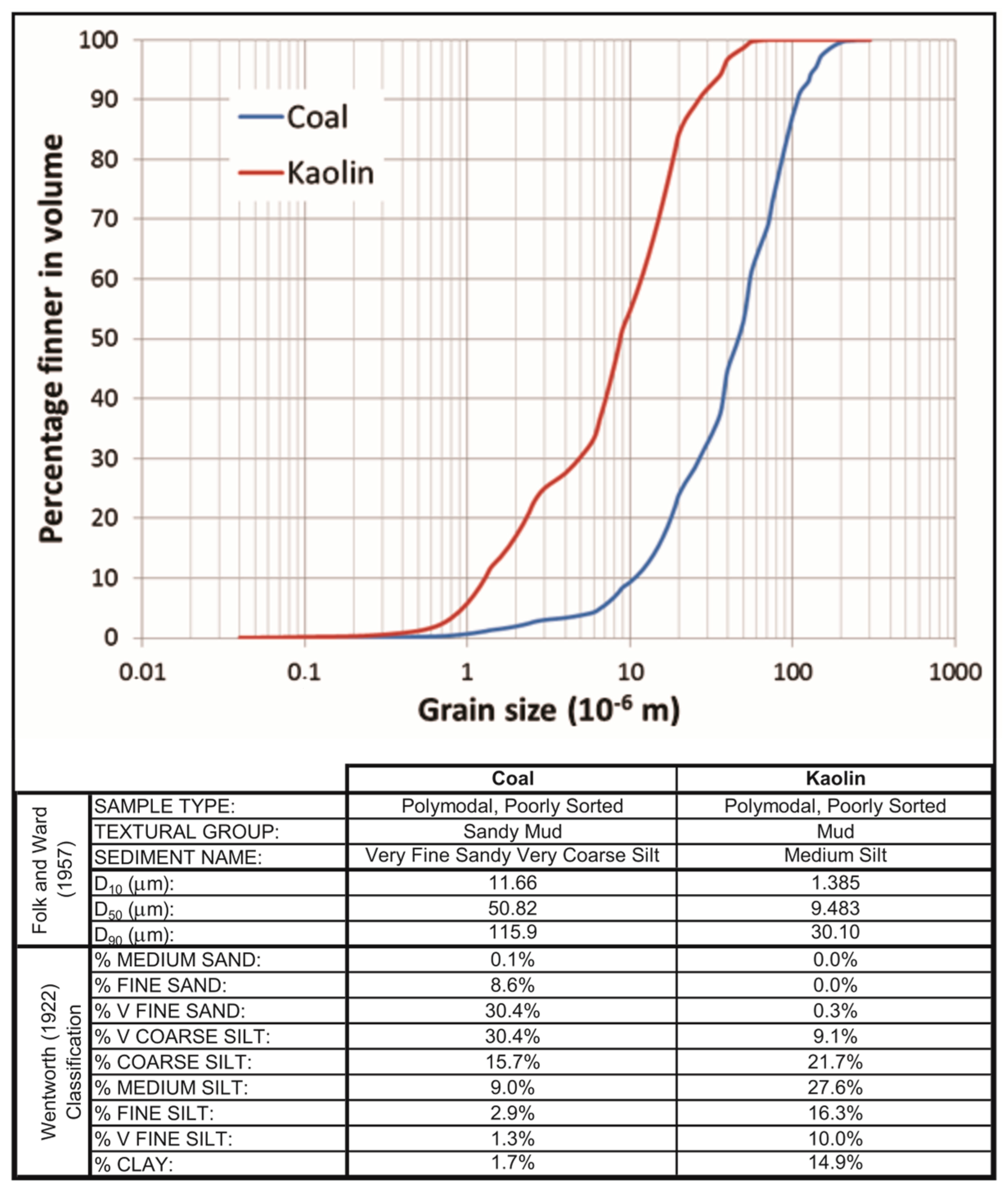

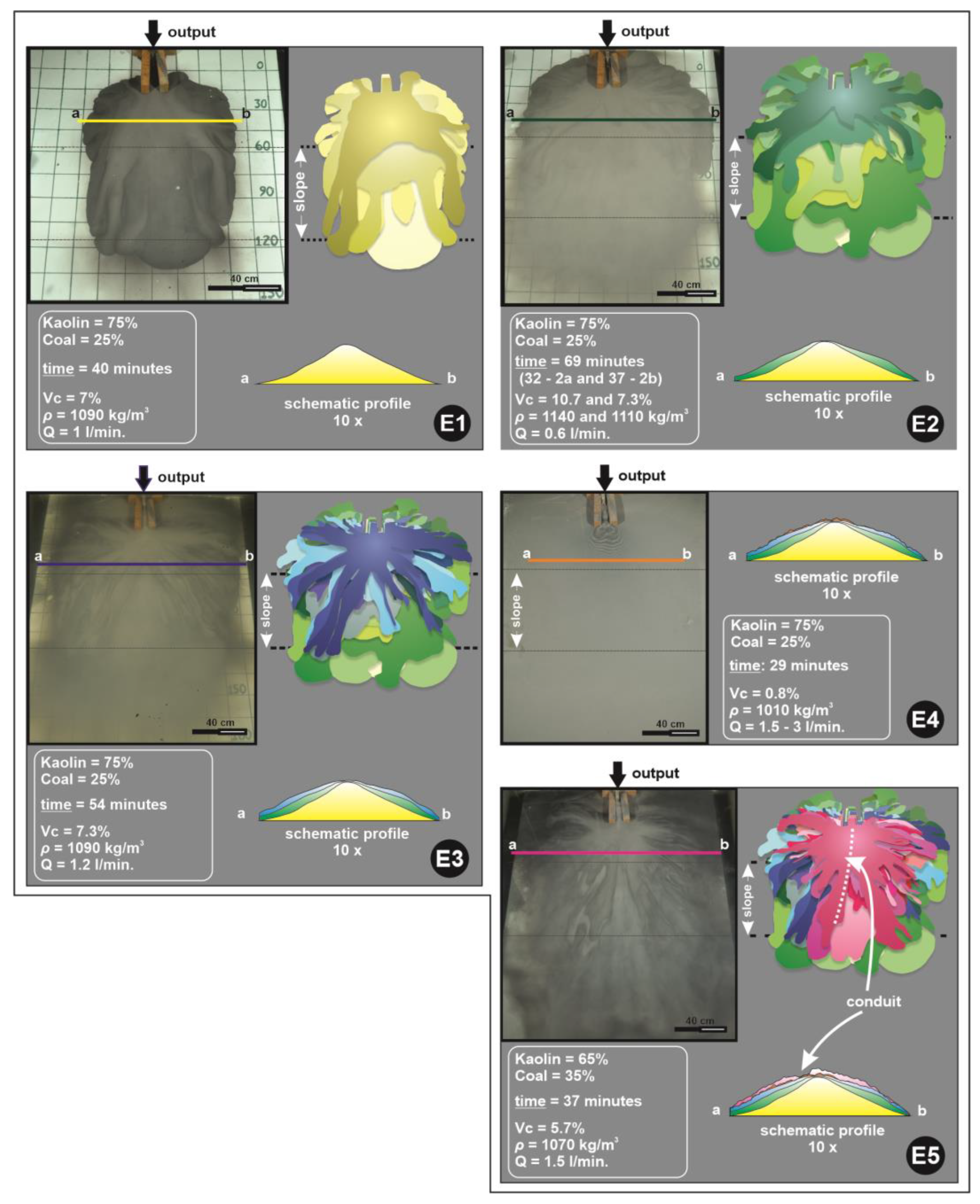
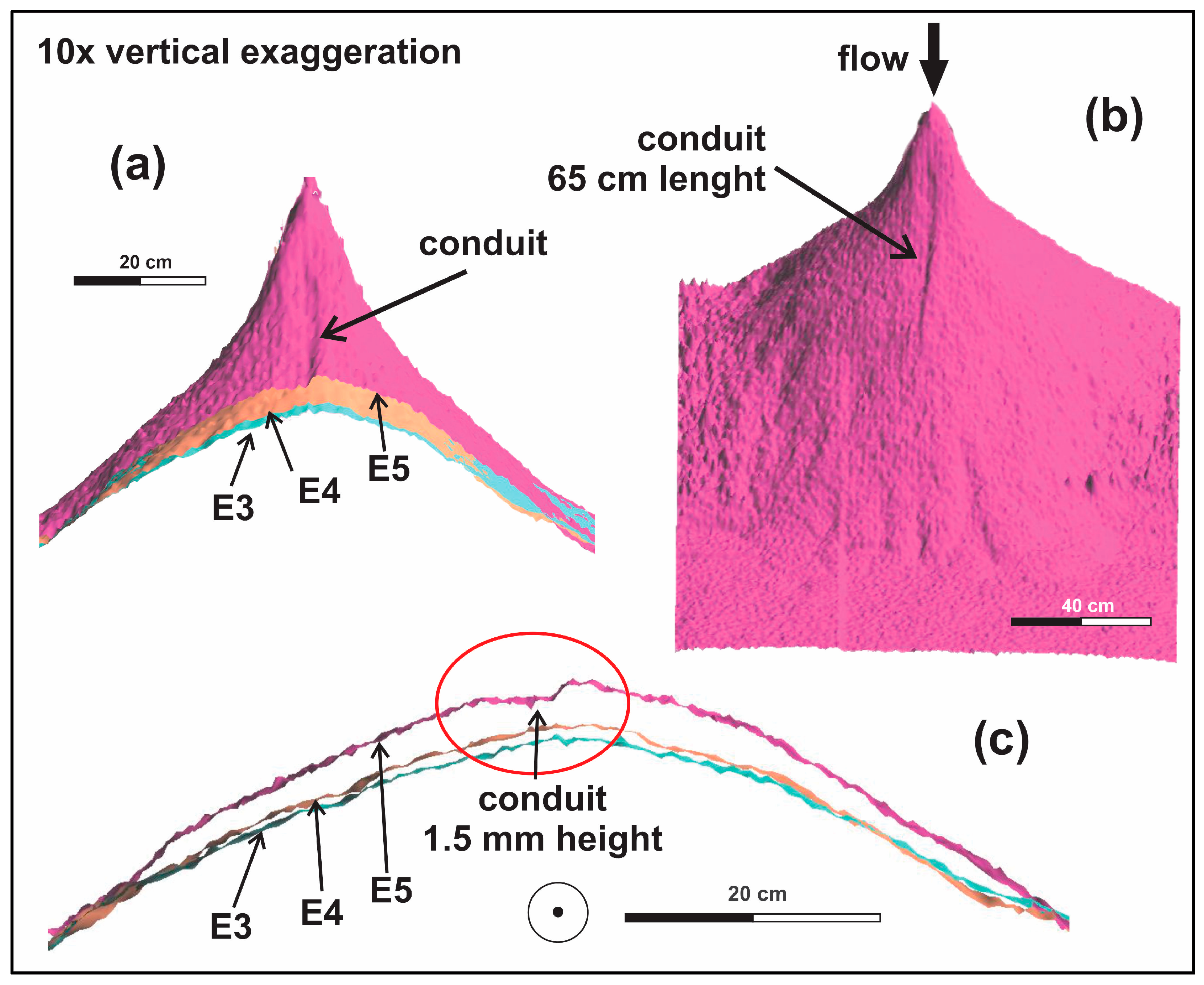
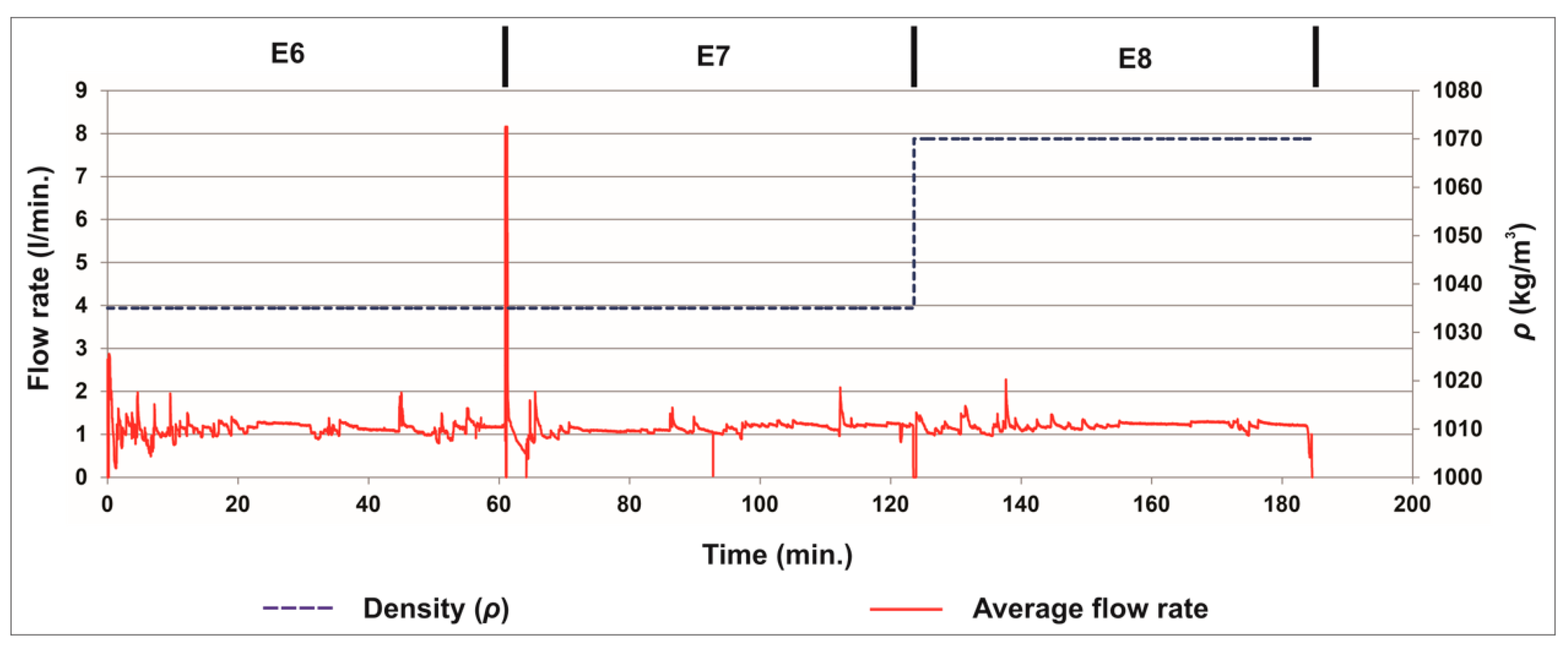
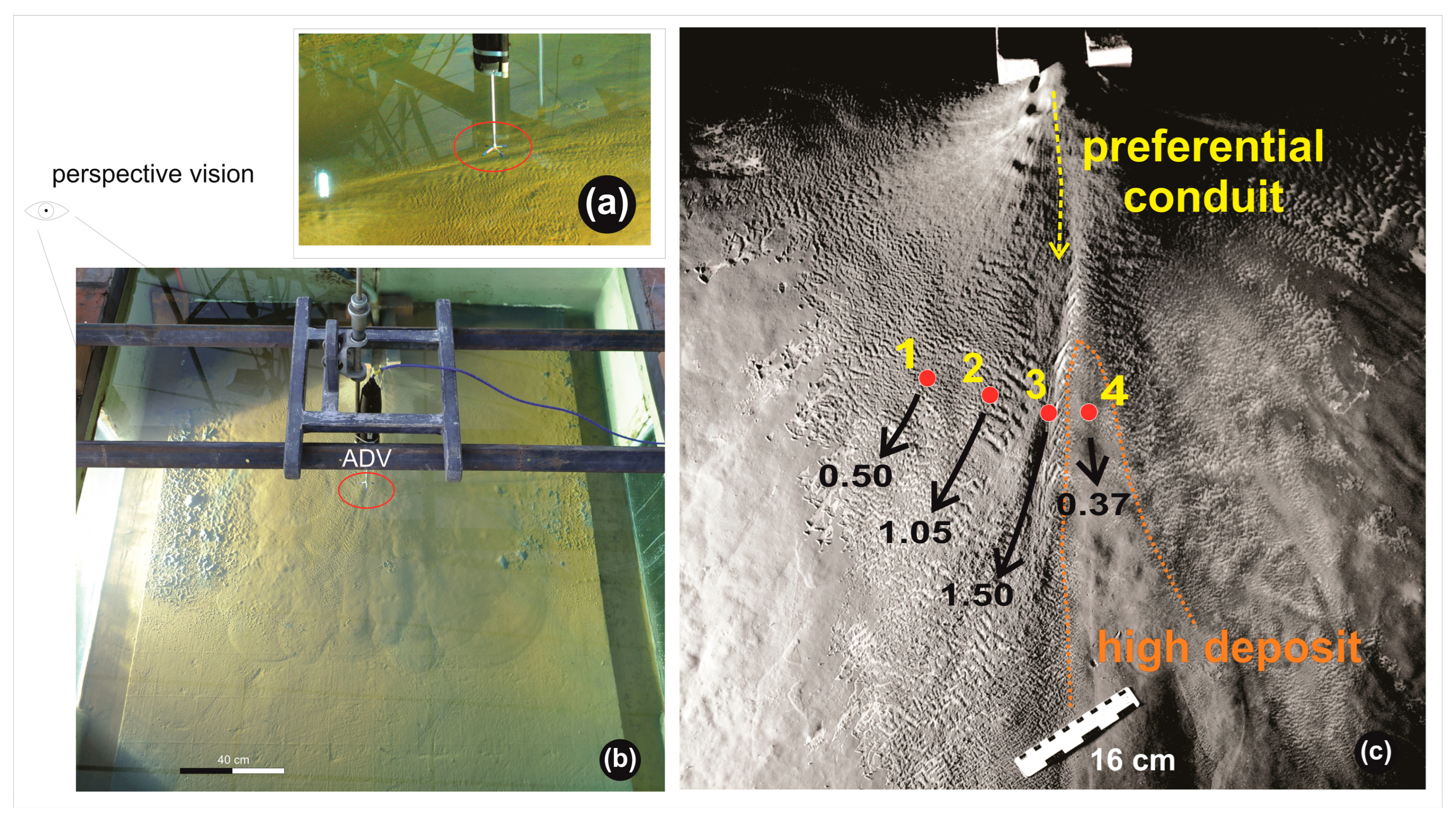

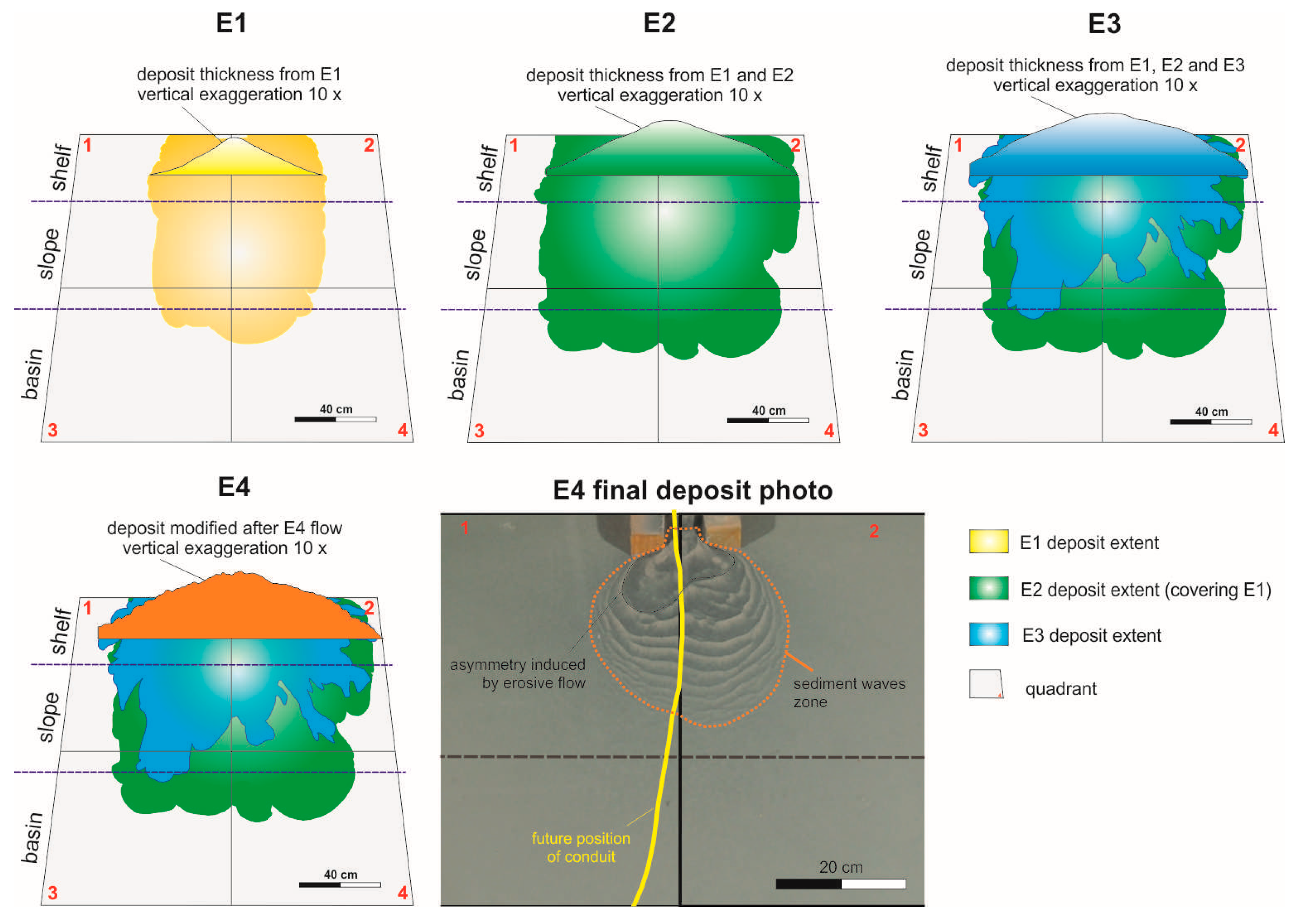
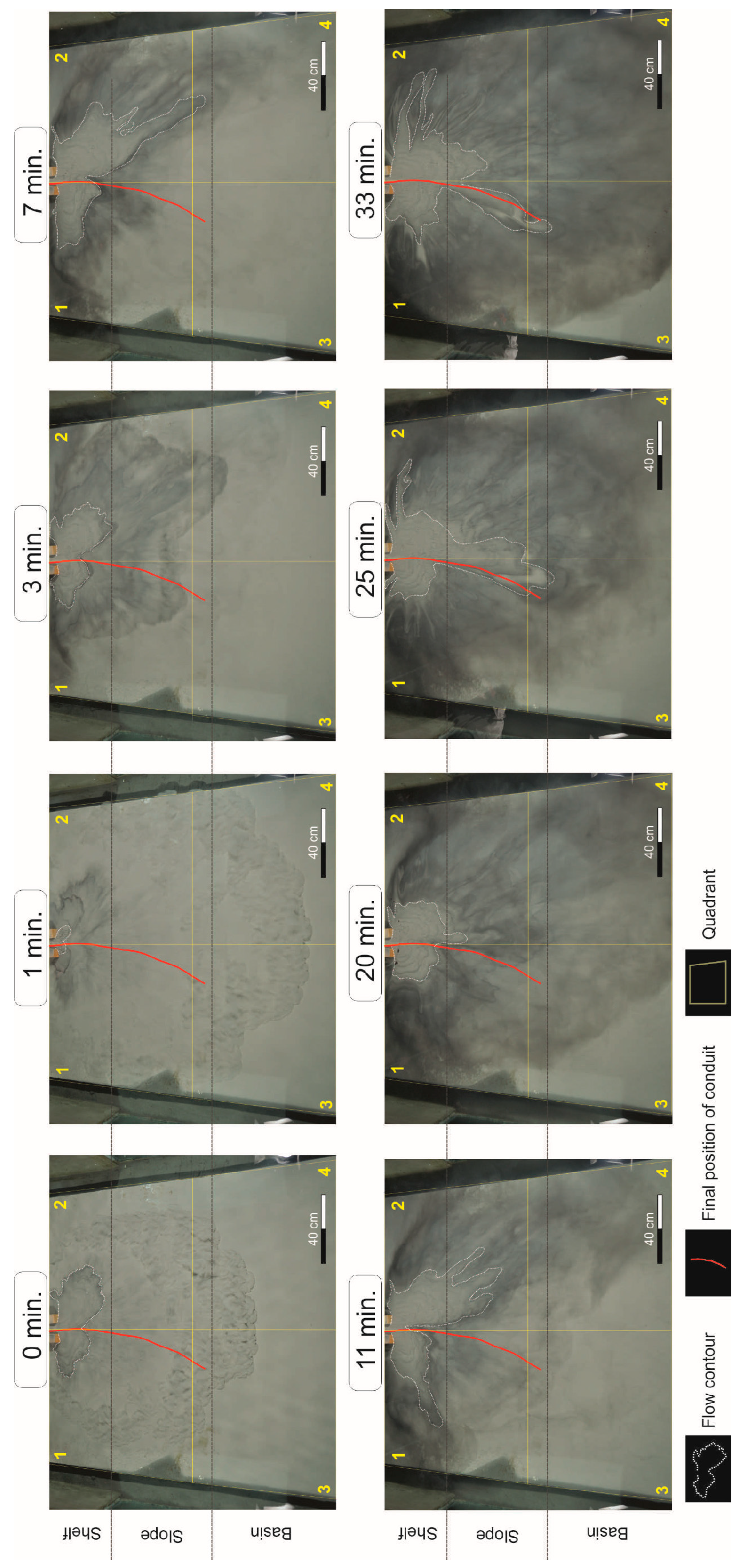
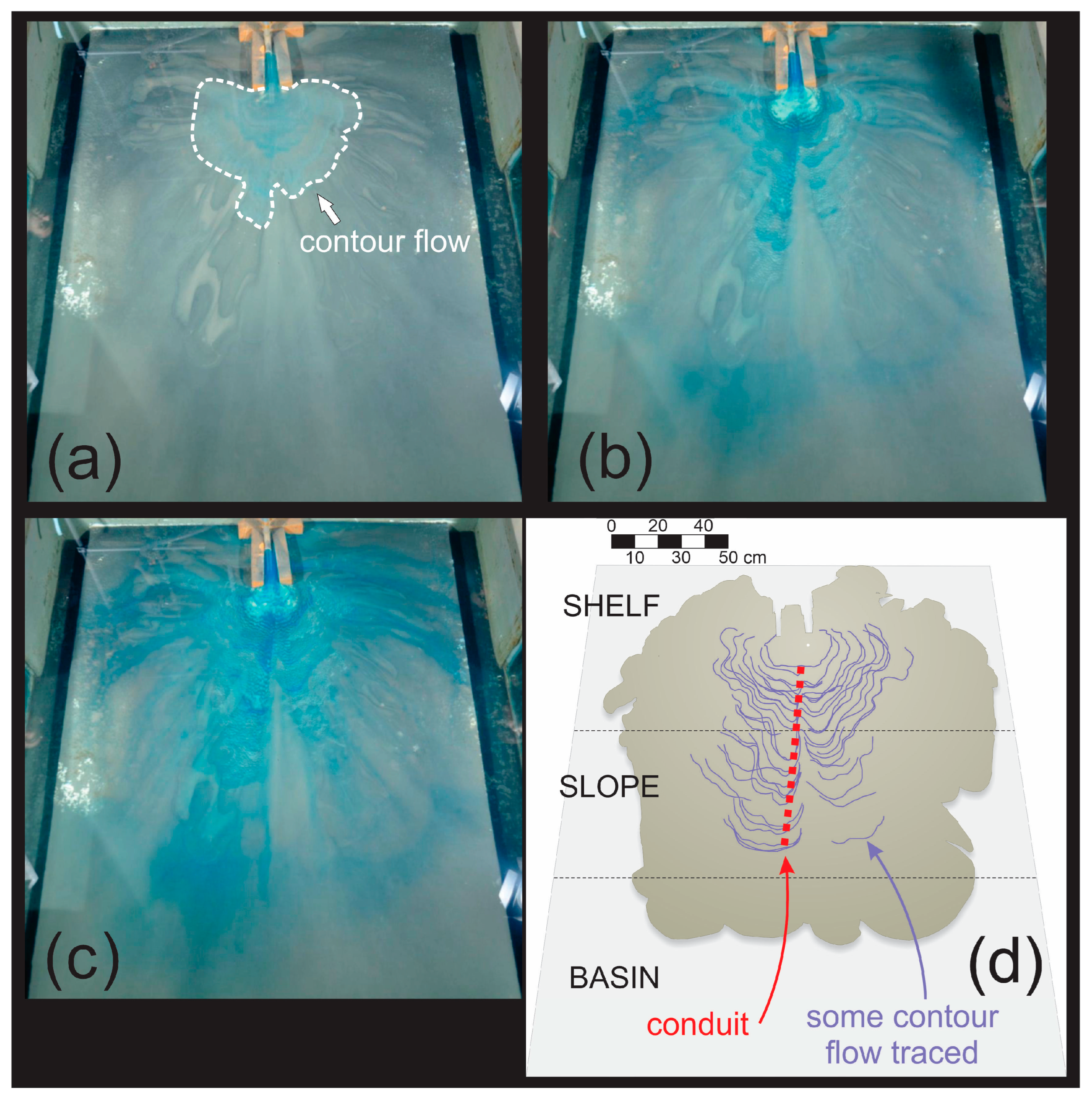

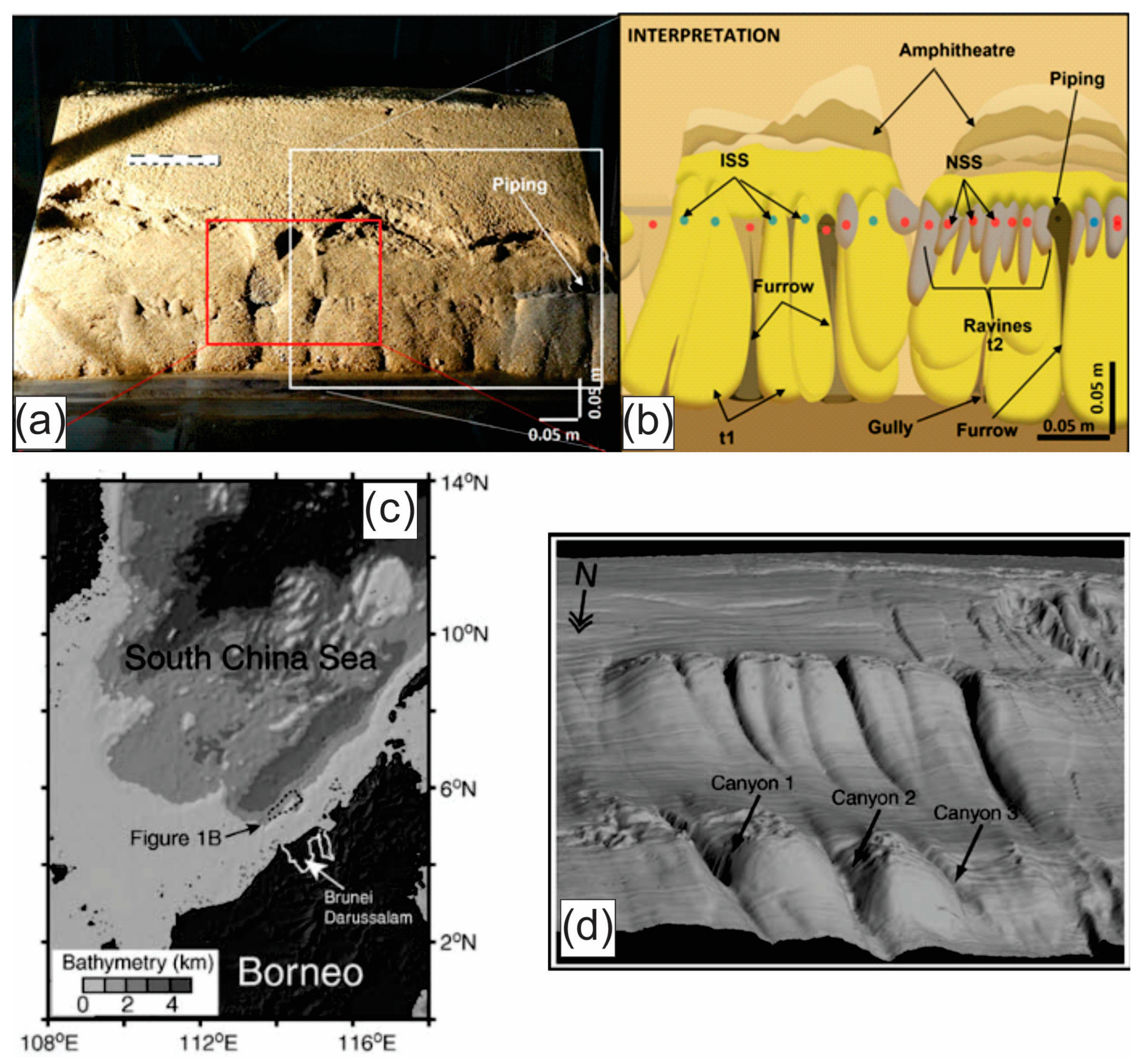

| Submarine Conduits | Locality | Length (km) | Reference | |
|---|---|---|---|---|
| Submarine canyon | Hawaiian Islands | Hawaii | 10 | [59] |
| La Jolla | Southern California | 14 | [4] | |
| Amazon | Northern Brazil | 60 | [80] | |
| Arenys | Catalan margin | 76 | [81] | |
| Foix | Catalan margin | 97 | [81] | |
| Monterey | Monterey Bay, California | 122 | [82] | |
| Blanes | Catalan margin | 184 | [81] | |
| Navarinsk | Bering Sea | 258 | [83] | |
| Bering | Bering Sea | 400 | [84] | |
| Submarine channel | Channel A | Brunei Darussalam offshore | 25 | [73] |
| Channel levee | Western Niger delta | 95 | [62] | |
| Magdalena | Caribbean Sea | 184 | [85] | |
| Valencia | NW Mediterranean Basin | 430 | [81] | |
| Amazon | Northern Brazil | 807 | [80] | |
| Bengal | Bay of Bengal | 3000 | [78] | |
| Gully | Noggin canyons | Great Barrier Reef margin | >0.1 | [52] |
| Cook Strait | Hikurangi subduction margin | 0.15–1.6 | [86] | |
| Simeto river mouth | Italian upper slope | 0.2–3 | [43] | |
| Volturno river mouth | Italian upper slope | 1–4 | [43] | |
| Tiber delta mouth | Italian upper slope | 1.5–5.5 | [43] | |
| Antarctic margin | Antarctic Peninsula | <10 | [59] | |
| Arctic margin | Norway and Svalbard continental margin | >10 | [59] | |
| Gabon | Margin of Gabon | 6.5–60 | [87] | |
| Series | Run | Mixture Sediment Composition (%) K = kaolin; C = coal | Volumetric Concentration (Vc%) | Average Flow Rate (L/min) | Mixture Density (kg/m3) | Duration (min) |
|---|---|---|---|---|---|---|
| Series I | E1 | K = 75; C = 25 | 7.04 | 1 | 1090.5 | 40 |
| E2a | K = 75; C = 25 | 10.70 | 0.6 | 1137.5 | 32 | |
| E2b | K = 75; C = 25 | 7.34 | 0.6 | 1108.8 | 37 | |
| E3 | K = 75; C = 25 | 7.29 | 1.2 | 1093.8 | 55 | |
| E4 | K = 75; C = 25 | 0.83 | 1.5–3 | 1010.6 | 30 | |
| E5 | K = 65; C = 35 | 5.68 | 1.5 | 1065.3 | 37 | |
| Series II | E6 | Salt | - | 1.25 | 1035 | 61 |
| E7 | Salt | - | 1.20 | 1035 | 62 | |
| E8 | Salt | - | 1.25 | 1070 | 62 |
| Velocities for Each Measurement Point (cm s−1) | |||
|---|---|---|---|
| Run | Distance from Bottom (mm) | E7 | E8 |
| (1) Away from conduit | 28 | 0.50 (14) | - |
| (2) Next to conduit | 25 | 1.05 (13) | - |
| (3) Conduit | 23(E7)/25(E8) | 1.50 (13) | 1.36 (30) |
| (4) High deposit | 28 | - | 0.37 (30) |
Disclaimer/Publisher’s Note: The statements, opinions and data contained in all publications are solely those of the individual author(s) and contributor(s) and not of MDPI and/or the editor(s). MDPI and/or the editor(s) disclaim responsibility for any injury to people or property resulting from any ideas, methods, instructions or products referred to in the content. |
© 2024 by the authors. Licensee MDPI, Basel, Switzerland. This article is an open access article distributed under the terms and conditions of the Creative Commons Attribution (CC BY) license (https://creativecommons.org/licenses/by/4.0/).
Share and Cite
Bayer da Silva, D.; Puhl, E.; Manica, R.; de Oliveira Borges, A.L.; Viana, A.R. Inception of Constructional Submarine Conduit by Asymmetry Generated by Turbidity Current. J. Mar. Sci. Eng. 2024, 12, 1476. https://doi.org/10.3390/jmse12091476
Bayer da Silva D, Puhl E, Manica R, de Oliveira Borges AL, Viana AR. Inception of Constructional Submarine Conduit by Asymmetry Generated by Turbidity Current. Journal of Marine Science and Engineering. 2024; 12(9):1476. https://doi.org/10.3390/jmse12091476
Chicago/Turabian StyleBayer da Silva, Daniel, Eduardo Puhl, Rafael Manica, Ana Luiza de Oliveira Borges, and Adriano Roessler Viana. 2024. "Inception of Constructional Submarine Conduit by Asymmetry Generated by Turbidity Current" Journal of Marine Science and Engineering 12, no. 9: 1476. https://doi.org/10.3390/jmse12091476
APA StyleBayer da Silva, D., Puhl, E., Manica, R., de Oliveira Borges, A. L., & Viana, A. R. (2024). Inception of Constructional Submarine Conduit by Asymmetry Generated by Turbidity Current. Journal of Marine Science and Engineering, 12(9), 1476. https://doi.org/10.3390/jmse12091476






